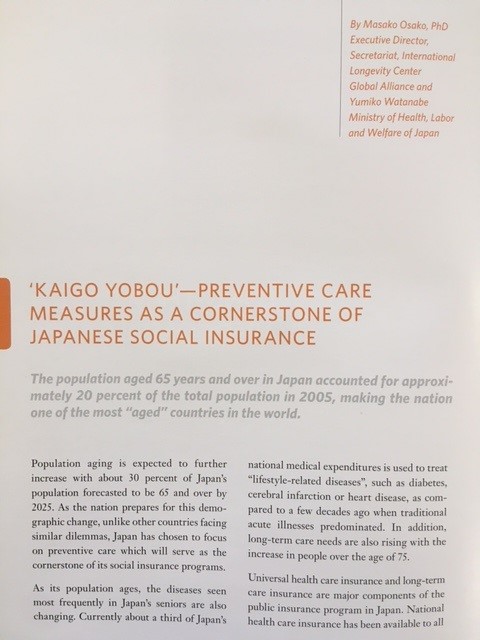31st December 2008
Population aging is expected to further increase with about 30 percent of Japan’s population forecasted to be 65 and over by 2025. As the nation prepares for this demographic change, unlike other countries facing similar dilemmas, Japan has chosen to focus on preventive care which will serve as the cornerstone of its social insurance programs.
Universal health care insurance and long-term care insurance are major components of the public insurance program in Japan. National health care insurance has been available to all
Japanese citizens since 1961. Long-term care insurance, introduced in 2000, is supported by the mandatory participation of all Japanese aged 40 and over and provides benefits mainly to persons aged 65 and over.
Public social and health expenditures in Japan are relatively low compared to European countries. (For instance, the comparison of public, social and health expenditures as percentage of GDP, 2001 shows 17.4% in Japan vs. 22.4% for the UK and 28.8% in Germany.) They are, however, projected to increase rapidly in Japan.
Faced with these challenges, Japan has launched a series of reforms over the past few years—social security pension reform in 2004, long-term care insurance reform in 2005 and
health care insurance reform in 2006. The common theme of the 2005 and 2006 reforms was the incorporation of “preventive care” as the foundation of each insurance scheme.
The benefits of long-term care insurance in Japan are provided in-kind rather than in cash as in the German system. Not only facility care, such as that which might be provided by a nursing home, but also home care including home help, respite care, day care and visiting nurse services are provided under this insurance system.
Since the introduction of long-term care insurance in 2000, use of these services has increased significantly, almost doubling in the first five years.
In the Long-term Care Insurance program, utilizing the certification procedure already in place, the insurer, namely the municipal government, identifies those older adults who are suitable for participation in various prevention programs. These individuals are categorized as either Support Level 1 or 2 (that is, least disabled) out of a possible seven levels.
Upon certification, each individual receives a customized care plan which emphasizes those services intended to maintain or improve his/her existing conditions. Preventive services
include physical exercise, nutritional care, and oral care. The progress of each individual is monitored every 3-6 months by a case manager. In addition, under the 2005 reform of the long-term care system, those elderly who are on the threshold of being classified as Support Level 1 can also receive some preventive services based on their specific situation.
According to the Ministry of Health, Labour and Welfare’s estimation, this new preventive care system should produce a 10 percent reduction in insurance outlays by 2015. This new direction is expected not only to have financial repercussions but also to enhance the quality of life of the elderly.
In conclusion:
Japan has made a clear and unique policy decision that prevention is key to the sustainability of its health care and long-term care insurance systems. Though it remains to be seen how successful the reforms discussed in this article will be, given the reality of global aging, the outcome of Japan’s efforts should merit close attention by those concerned with constructing sustainable social welfare and health insurance systems.
Contact information: mo2478@cumc.columbia.edu



